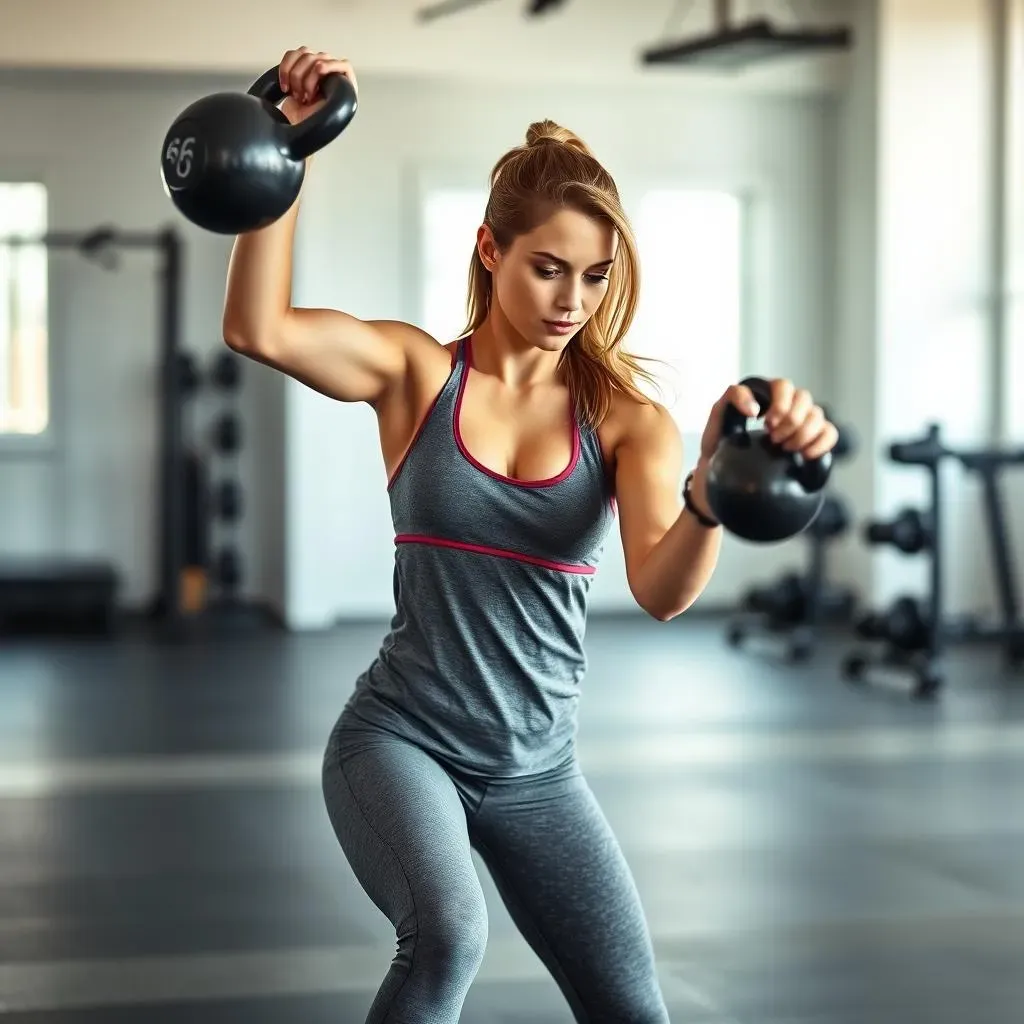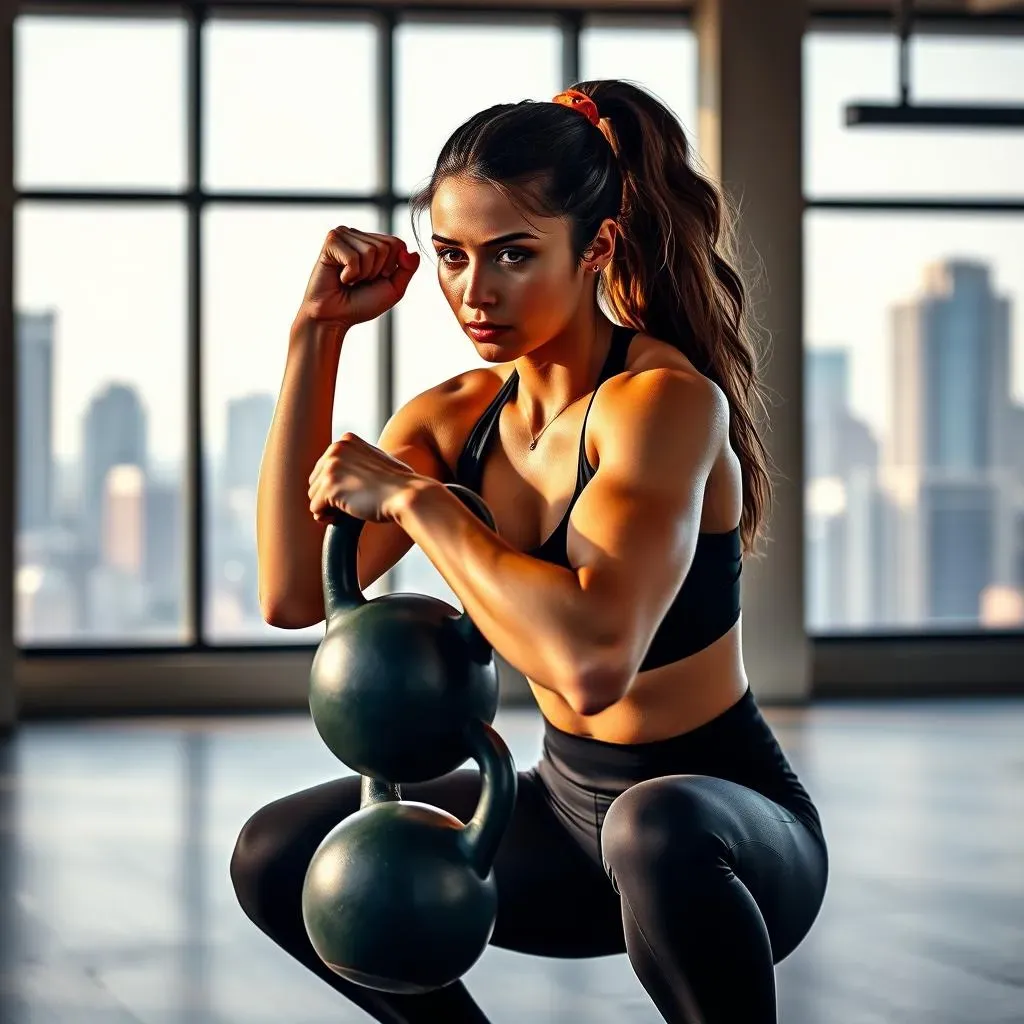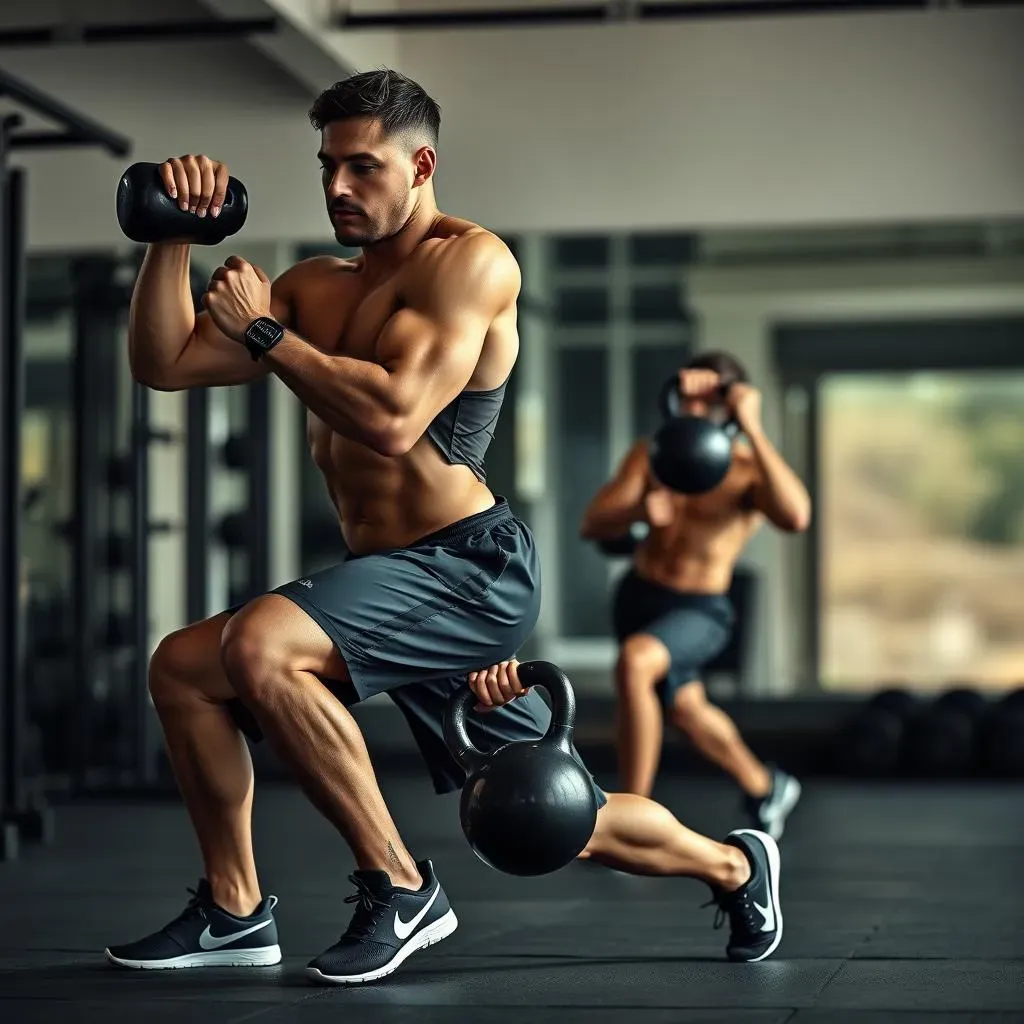Table of Contents
Ready to unlock your fitness potential? This article unveils the 7 best kettlebell exercises to supercharge your workouts and transform your body. Forget boring routines – kettlebells offer a dynamic, full-body challenge that builds strength, burns fat, and improves overall fitness. We'll break down the essential techniques for each exercise, ensuring you perform them safely and effectively. Whether you're a seasoned athlete or a complete beginner, this guide will equip you with the knowledge to create a powerful and efficient kettlebell routine. Get ready to discover why kettlebells are a game-changer for achieving your fitness goals. We'll cover the fundamentals of the kettlebell swing, a cornerstone exercise for building power and endurance. Then, we'll explore how to master goblet squats and deadlifts for serious lower-body strength. Finally, we'll round out your full-body routine with kettlebell rows, lunges, and presses. So, grab your kettlebell, and let's get started on your journey to a stronger, fitter you! This article will equip you with the knowledge and confidence to master the 7 best kettlebell exercises. Let's dive in!
Mastering the Kettlebell Swing: Technique and Variations

Mastering the Kettlebell Swing: Technique and Variations
The Foundation: Setting Up for Success
Hey there! So you're diving into the world of kettlebell swings? Fantastic choice! It's a seriously effective exercise, but getting the technique right is key. Think of it like this: the swing isn't about brute force; it's about harnessing your body's natural power. Start with a lighter kettlebell – you want to focus on perfect form, not lifting the heaviest weight possible. Stand with your feet shoulder-width apart, toes slightly pointed outwards. Keep your back straight – imagine a string pulling you up from the crown of your head. Grab the kettlebell with an overhand grip, keeping your arms straight but not locked. This is your starting position. Remember, proper form prevents injuries and maximizes results. For beginners, check out this beginner kettlebell workout to get started.
Now, hinge at your hips, pushing your butt back as if you're about to sit in a chair. Keep your back straight, and let the kettlebell swing between your legs. This is the hinge movement. Don't round your back – that's a recipe for disaster! Once the kettlebell reaches its lowest point, explosively drive through your hips, squeezing your glutes, and swinging the kettlebell up to around chest height. The power comes from your hips, not your arms. Your arms simply act as guides for the kettlebell. Control the swing and avoid jerky movements. As you become more comfortable, you can add more weight, but always prioritize perfect form over heavy weight. A great resource is a beginner kettlebell strength workout that focuses on mastering the swing.
Step | Action | Focus |
|---|---|---|
1 | Feet shoulder-width apart, slight outward toe point | Stable base |
2 | Hinge at hips, back straight, kettlebell between legs | Hip hinge, not back bend |
3 | Drive through hips, swing kettlebell to chest height | Power from hips, controlled swing |
Adding Variations and Progression
Once you've nailed the basic kettlebell swing, it's time to explore some variations! The Russian kettlebell swing is similar, but the kettlebell doesn't swing as high – it stays more parallel to the ground. This variation focuses more on core strength and endurance. Another popular option is the American kettlebell swing, where the kettlebell is swung higher, almost to shoulder level. This variation works more of the upper body. You can also play around with the number of repetitions and sets to challenge yourself. Start with 10-15 repetitions for 3 sets, resting for 60 seconds between sets. As you get stronger, increase the number of repetitions, sets, or even try a longer 30-minute kettlebell workout.
Remember, consistency is key. Regular practice will refine your technique and build your strength. Don't be afraid to experiment with different variations and find what works best for your body. The kettlebell swing is a versatile exercise that can be adapted to suit various fitness levels and goals. It's a fantastic way to improve your cardiovascular fitness, build strength, and challenge your core. If you’re looking for a more comprehensive routine, consider a full-body beginner kettlebell workout that incorporates the swing with other exercises.
- Russian Kettlebell Swing: Lower swing arc, emphasizes core.
- American Kettlebell Swing: Higher swing arc, more upper body engagement.
- Increase reps/sets: Gradually increase the challenge.
- Vary rest times: Adjust for intensity and recovery.
Building Strength: Kettlebell Goblet Squats and Deadlifts

Building Strength: Kettlebell Goblet Squats and Deadlifts
Goblet Squats: The King of Lower Body Exercises
Let's talk goblet squats! This is where you hold the kettlebell close to your chest, like you're holding a big, heavy goblet. It's amazing for building leg and core strength. Stand with your feet shoulder-width apart, toes slightly pointed outwards. Hold the kettlebell vertically, with both hands gripping the horn. Now, lower yourself down as if you're sitting in a chair, keeping your back straight and your chest up. Make sure your knees don't go past your toes. Push through your heels to stand back up, squeezing your glutes at the top. It's all about controlled movement. Start with a weight you can comfortably handle for 8-12 reps. Need a quick workout? Check out this 10-minute kettlebell workout that includes goblet squats.
Focus on maintaining a straight back throughout the movement, and don't let your knees cave inwards. This exercise is fantastic for building lower body strength, improving balance, and strengthening your core. Remember to breathe! Inhale as you lower yourself down, and exhale as you stand back up. As you get stronger, increase the weight or the number of reps. You'll feel the burn in your legs and glutes, and you'll be amazed at how quickly you see results! For a more detailed guide, you might find a beginner kettlebell workout for women helpful.
- Proper form: Straight back, chest up, knees aligned.
- Controlled movement: Avoid jerky movements.
- Progressive overload: Increase weight or reps as you get stronger.
Kettlebell Deadlifts: Power and Precision
Next up, the kettlebell deadlift! This is a total-body powerhouse exercise that'll boost your strength significantly. It works your entire posterior chain – that's your back, glutes, and hamstrings. Start by standing with your feet hip-width apart, the kettlebell in front of you. Bend down and grab the kettlebell with an overhand grip. Your back should remain straight – imagine that string pulling you up from the top of your head again. Keeping your back straight, lift the kettlebell by driving through your heels, engaging your glutes and hamstrings. Think about squeezing your glutes at the top of the movement. Lower the kettlebell back down in a controlled manner. For beginners, start with a lighter kettlebell and focus on form before increasing weight.
Remember to keep your core engaged throughout the lift – this helps stabilize your spine and prevents injuries. Avoid rounding your back, and make sure you're using your legs and glutes to lift the weight, not your back. Start with 8-12 reps for 3 sets, and gradually increase the weight as you get stronger. If you're looking for a full-body routine, this full-body beginner kettlebell workout is a great starting point. Pay close attention to your form – you should feel the weight in your legs and glutes, not your lower back. Listen to your body and stop if you feel any pain. Proper technique is key to maximizing results and avoiding injuries.
Step | Action | Focus |
|---|---|---|
1 | Feet hip-width apart, kettlebell in front | Stable base, proper grip |
2 | Bend, grab kettlebell, straight back | Maintain spinal alignment |
3 | Lift, drive through heels, squeeze glutes | Leg and glute power |
Combining Goblet Squats and Deadlifts for Maximum Results
Now, let's talk about combining these two awesome exercises. Goblet squats and kettlebell deadlifts are a match made in fitness heaven! They work different muscle groups but complement each other beautifully. By incorporating both into your routine, you'll target your entire lower body, building strength, power, and stability. You can alternate between sets of goblet squats and deadlifts, or even create a circuit that includes both exercises. This 4-day kettlebell workout might give you some ideas on how to structure your training. Remember to always prioritize proper form over the amount of weight you lift.
Listen to your body and adjust the weight and reps as needed. Don't push yourself too hard, especially when you're starting out. Consistency is key to seeing results. Start with a few sessions a week, gradually increasing the frequency and intensity as you get fitter and stronger. Remember, progress takes time, so be patient and celebrate your achievements along the way! And remember to always warm up before you start your workout and cool down afterwards. A good warm-up will prepare your muscles for the workout, reducing the risk of injury. A cool-down will help your muscles recover, reducing soreness and stiffness.
- Alternate sets: Goblet squats then deadlifts.
- Create a circuit: Combine exercises for a challenging workout.
- Listen to your body: Adjust weight and reps as needed.
- Consistency is key: Stick to your routine for optimal results.
FullBody Blast: Kettlebell Rows, Lunges, and Presses

FullBody Blast: Kettlebell Rows, Lunges, and Presses
Kettlebell Rows: Building Upper Body Strength
Alright, let's talk kettlebell rows! This exercise is fantastic for building upper body strength and improving posture. Imagine a single-arm row but with a kettlebell – that’s the essence of it. You'll need a sturdy surface, like a bench or sturdy chair, to support one knee and hand. Grab your kettlebell with one hand, keeping your back straight and core engaged. Let the kettlebell hang down towards the floor. Now, pull the kettlebell up towards your chest, squeezing your shoulder blades together at the top. Lower it back down slowly and in a controlled manner. Repeat for the desired number of reps, and then switch sides. For a great beginner routine, check out this beginner kettlebell workout using a blender bottle—it's a fun way to get started!
Remember to keep your back straight throughout the movement, and avoid swinging the kettlebell. The power should come from your back muscles, not momentum. Focus on the squeeze in your shoulder blades at the top of the movement – this helps to activate the muscles effectively. Start with a lighter kettlebell and gradually increase the weight as you get stronger. If you feel any pain, stop immediately and reassess your form. Proper form is crucial to prevent injuries. Aim for 8-12 reps per side for 3 sets. This exercise will sculpt your back muscles and improve your overall upper body strength and definition.
- Maintain a straight back
- Engage your core
- Squeeze shoulder blades at the top
- Controlled movement
Kettlebell Lunges: Targeting Legs and Glutes
Next up, let's hit those legs and glutes with kettlebell lunges! This is a fantastic exercise for building lower body strength and improving balance and coordination. Hold a kettlebell in each hand, or one heavier kettlebell in both hands. Start by standing with your feet hip-width apart. Take a big step forward with one leg, lowering your body until both knees are bent at a 90-degree angle. Make sure your front knee doesn't go past your toes. Push off with your front foot to return to the starting position. Repeat for the desired number of reps, and then switch legs. For a killer workout, try this 30-minute beginner kettlebell workout that includes lunges.
Remember to keep your core engaged throughout the movement, and maintain a straight back. Focus on controlling the descent and ascent, and avoid any jerky movements. Start with a lighter kettlebell and gradually increase the weight as you get stronger. Lunges are a great way to build strength and endurance in your legs and glutes, and they also help improve balance and coordination. This exercise is a fantastic addition to any full-body workout. Aim for 10-15 reps per leg for 3 sets. You'll feel the burn in your legs and glutes, and you'll be amazed at how quickly you see results!
Step | Action | Focus |
|---|---|---|
1 | Hold kettlebell(s), feet hip-width apart | Balanced stance |
2 | Step forward, bend knees to 90 degrees | Controlled descent |
3 | Push off front foot, return to start | Power through front leg |
Kettlebell Shoulder Press: Sculpting Your Shoulders and Upper Body
Finally, let's finish off with the kettlebell shoulder press! This exercise is a classic for building shoulder strength and definition. It also works your upper back and core muscles. Start by standing with your feet shoulder-width apart, holding a kettlebell in each hand at shoulder height. Keep your elbows slightly bent and your core engaged. Press the kettlebells straight up overhead, extending your arms fully. Lower the kettlebells back down in a controlled manner, keeping your core engaged throughout the movement. Looking for a quick and effective workout? Check out this 10-minute beginner kettlebell workout.
Remember to keep your core engaged throughout the movement, and avoid arching your back. Start with a lighter kettlebell and gradually increase the weight as you get stronger. Focus on a slow and controlled movement, avoiding any jerky movements. The kettlebell shoulder press is a fantastic way to build strength and definition in your shoulders and upper body. It's a great addition to any full-body workout. Aim for 8-12 reps for 3 sets. You'll feel the burn in your shoulders and upper body, and you'll be amazed at how quickly you see results! Remember to listen to your body and stop if you feel any pain.
- Engage your core
- Controlled movements
- Avoid arching your back
- Gradual weight increase